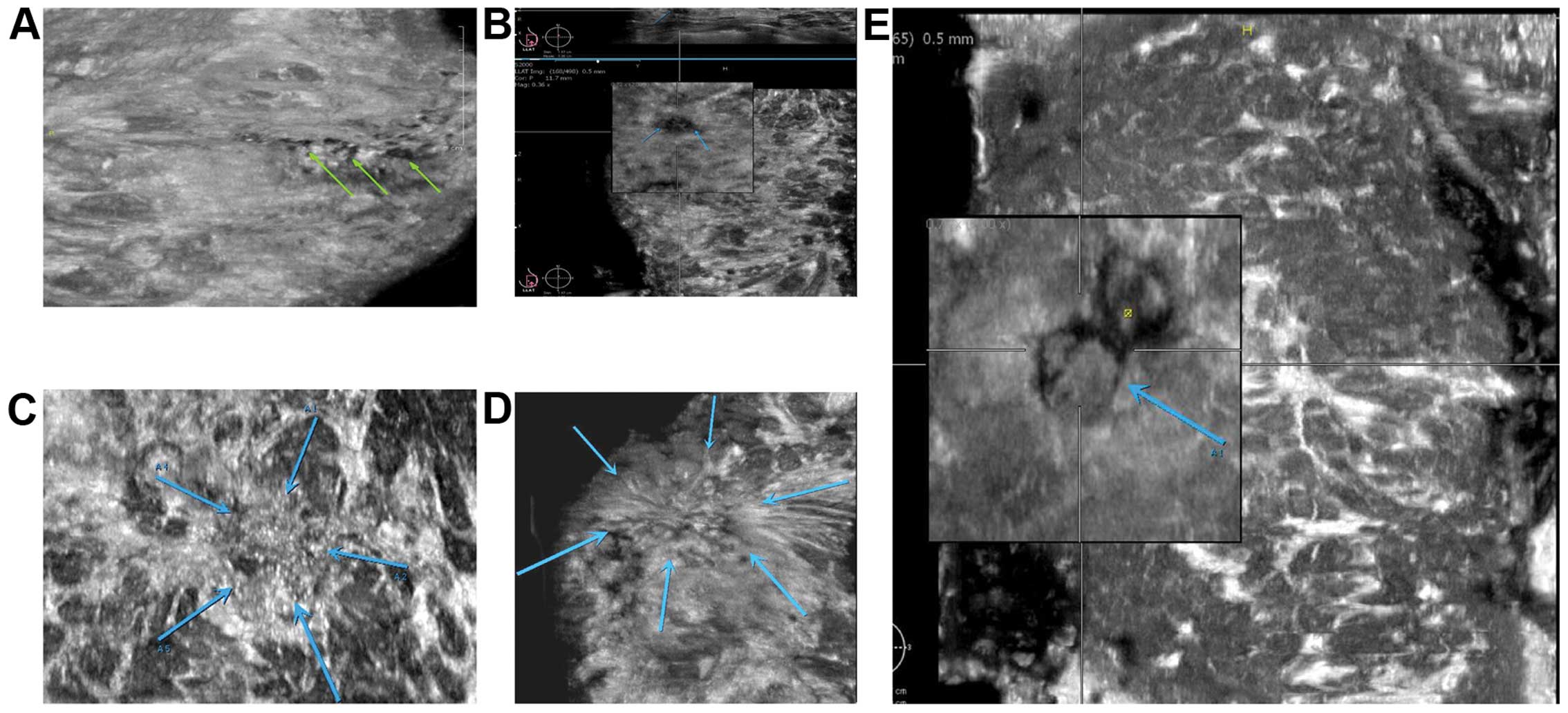|
1
|
Yang WT and Zhu XZ: The introduction of
2012 WHO classification of tumours of the breast. Zhonghua Bing Li
Xue Za Zhi. 42:78–80. 2013.(In Chinese). PubMed/NCBI
|
|
2
|
Si W, Li Y, Han Y, Zhang F, Wang Y, Li Y,
Linghu RX, Zhang X and Yang J: epidemiological and
clinicopathological trends of breast cancer in Chinese patients
during 1993 to 2013: A retrospective study. Medicine (Baltimore).
94:e8202015. View Article : Google Scholar : PubMed/NCBI
|
|
3
|
Bok SK, Jeon Y and Hwang PS:
Ultrasonographic evaluation of the effects of progressive resistive
exercise in breast cancer-related lymphedema. Lymphat Res Biol.
14:18–24. 2016. View Article : Google Scholar : PubMed/NCBI
|
|
4
|
Wojcinski S, Farrokh A, Hille U,
Wiskirchen J, Gyapong S, Soliman AA, Degenhardt F and Hillemanns P:
The automated breast volume scanner (ABVS): Initial experiences in
lesion detection compared with conventional handheld B-mode
ultrasound: A pilot study of 50 cases. Int J Womens Health.
3:337–346. 2011. View Article : Google Scholar : PubMed/NCBI
|
|
5
|
Shen WC, Chang RF and Moon WK: Computer
aided classifications system for breast ultrasound based on Breast
Imaging Reporting and Data System (BI-RADS). Ultrasound Med Biol.
33:1688–1698. 2007. View Article : Google Scholar : PubMed/NCBI
|
|
6
|
Wöhrle NK, Hellerhoff K, Notohamiprodjo M,
Reiser MF and Clevert DA: Automated breast volume scanner (ABVS): A
new approach for breast imaging. Radiologe. 50:973–981. 2010.(In
German). View Article : Google Scholar : PubMed/NCBI
|
|
7
|
Tozaki M, Isobe S, Yamaguchi M, Ogawa Y,
Kohara M, Joo C and Fukuma E: Optimal scanning technique to cover
the whole breast using an automated breast volume scanner. Jpn J
Radiol. 28:325–328. 2010. View Article : Google Scholar : PubMed/NCBI
|
|
8
|
Shin HJ, Kim HH, Cha JH, Park JH, Lee KE
and Kim JH: Automated ultrasound of the breast for diagnosis:
Interobserver agreement on lesion detection and characterization.
AJR Am J Roentgenol. 197:747–754. 2011. View Article : Google Scholar : PubMed/NCBI
|
|
9
|
Zhang Q, Hu B, Hu B and Li WB: Detection
of breast lesions using an automated breast volume scanner system.
J Int Med Res. 40:300–306. 2012. View Article : Google Scholar : PubMed/NCBI
|
|
10
|
Isobe S, Tozaki M, Yamaguchi M, Ogawa Y,
Homma K, Satomi R, Saito M, Joo C and Fukuma E: Detectability of
breast lesions under the nipple using an automated breast volume
scanner: Comparison with handheld ultrasonography. Jpn J Radiol.
29:361–365. 2011. View Article : Google Scholar : PubMed/NCBI
|
|
11
|
Li N, Jiang YX, Zhu QL, Zhang J, Dai Q,
Liu H, Yang Q, Wang HY, Lai XJ and Sun Q: Accuracy of an automated
breast volume ultrasound system for assessment of the pre-operative
extent of pure ductal carcinoma in situ: Comparison with a
conventional handheld ultrasound examination. Ultrasound Med Biol.
39:2255–2263. 2013. View Article : Google Scholar : PubMed/NCBI
|
|
12
|
Kim YW, Kim SK, Youn HJ, Choi EJ and Jung
SH: The clinical utility of automated breast volume scanner: A
pilot study of 139 cases. J Breast Cancer. 16:329–334. 2013.
View Article : Google Scholar : PubMed/NCBI
|
|
13
|
Golatta M, Franz D, Harcos A, Junkermann
H, Rauch G, Scharf A, Schuetz F, Sohn C and Heil J: Interobserver
reliability of automated breast volume scanner (ABVS)
interpretation and agreement of ABVS findings with hand held breast
ultrasound (HHUS), mammography and pathology results. Eur J Radiol.
82:e332–e336. 2013. View Article : Google Scholar : PubMed/NCBI
|
|
14
|
Garcia-Uribe A, Erpelding TN, Krumholz A,
Ke H, Maslov K, Appleton C, Margenthaler JA and Wang LV:
Dual-modality photoacoustic and ultrasound imaging system for
noninvasive sentinel lymph node detection in patients with breast
cancer. Sci Rep. 5:157482015. View Article : Google Scholar : PubMed/NCBI
|
|
15
|
Chen L, Chen Y, Diao XH, Fang L, Pang Y,
Cheng AQ, Li WP and Wang Y: Comparative study of automated breast
3-D ultrasound and handheld B-mode ultrasound for differentiation
of benign and malignant breast masses. Ultrasound Med Biol.
39:1735–1742. 2013. View Article : Google Scholar : PubMed/NCBI
|
|
16
|
Hao SY, Ou B, Li LJ, Peng YL, Wang Y, Liu
LS, Xiao Y, Liu SJ, Wu CJ, Jiang YX, et al: Could ultrasonic
elastography help the diagnosis of breast cancer with the usage of
sonographic BI-RADS classification? Eur J Radiol. 84:2492–2500.
2015. View Article : Google Scholar : PubMed/NCBI
|
|
17
|
Giuliano V and Giuliano C: Improved breast
cancer detection in asymptomatic women using 3D-automated breast
ultrasound in mammographically dense breasts. Clin Imaging.
37:480–486. 2013. View Article : Google Scholar : PubMed/NCBI
|
|
18
|
Tozaki M and Fukuma E: Accuracy of
determining preoperative cancer extent measured by automated breast
ultrasonography. Jpn J Radiol. 28:771–773. 2010. View Article : Google Scholar : PubMed/NCBI
|











